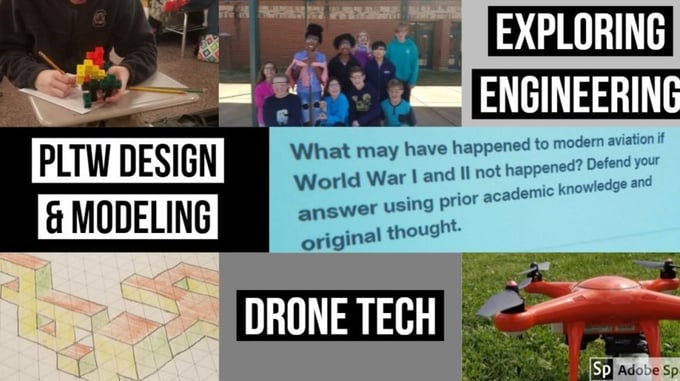Chris McCalla is a CTAE teacher at Long Cane Middle School in LaGrange, Georgia. Chris teaches PLTW Gateway unit Design and Modeling and also specializes in STEM curricula including Drone Tech and Exploring Engineering. Chris is a writer, former government affairs specialist, and weekend mechanic for his modest car collection.
Of all the lessons and activities in Design and Modeling, my absolute favorite one is Lesson 1, Activity 1.2: “A Picture is Worth a Thousand Words.” I’ll be honest, when I took the training course for this unit, this was, in the beginning, my least favorite and a frustrating part of those five days of my summer.
For whatever reason, my brain could not process three-dimensional shapes on a two-dimensional plane; I struggled for almost two days learning isometric sketching. Then, my “Eureka!” moment! It happened late on the second night of training, when I was holed up in my hotel room with a handful of snap cubes, isometric paper, and mechanical and coloring pencils. All of the sudden, it all came together. Man, I was so excited – I could hardly contain myself. I stayed up late sketching shape after shape. Isometric sketching became really fun, really cool stuff.
Fast-forward to my first week of the new school year. I’m in my design class with my new students and as I explain the sketching process, they work along with me from their desks. With each class, there were always one or two students who were way ahead of the class’s – and my – skills. Then there were those two or three other students who were like me in my learning stages – they could not grasp the concept. That rewarding teaching moment never got old when it all came together for a struggling student who would shout out in class, “I got it, Mr. McCalla!” I knew exactly how they felt and would share the story of my challenges learning isometric sketching.
Students sometimes appreciate hearing that their teachers do not know everything, and they, too, struggle with new concepts. Knowing teachers sometimes struggle helps ease their own temporary frustrations.
Along with isometric sketching, one other cool aspect that stood out for me was how the Design and Modeling curriculum offers something for nearly every student. Students might love art and drawing; this curriculum’s got them covered. Maybe when students were younger, they loved building forts, spaceships, or even games out of empty boxes and other stuff they found around their house. Check that box – those skills will shine in this class. Maybe another student loves three-dimensional puzzles or that golf tee game you see at Cracker Barrel – you know, the one where you jump one tee at a time, and the game’s objective is to leave as few tees as possible? Well, Design and Modeling appeals to that student, too. I’ve taught athletes, musicians, singers, math whizzes, and just about every student in between, including several exceptional education students, and each one enjoyed Design and Modeling. I mean, seriously, who dislikes puzzles?
PLTW’s blog intends to serve as a forum for ideas and perspectives from across our network. The opinions expressed are those of each guest author.


